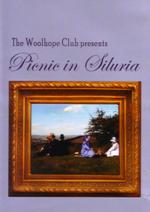Picnic in Siluria
Format: DVD
Running time: 26m
Released by: The Woolhope Club
Produced by: Field of Vision www.fieldofvision.co.uk
Published: 2008
Copies from: Dr Paul Olver, The Buttridge, Wellington Lane, CANON PYON, Hereford, HR4 8NL T: 01432 761693; E: [email protected]
Price: £12-00
www.woolhopeclub.org.uk

On 18 May 1852, members of the Woolhope Naturalists’ Field Club (founded 1851) were taken on their first ever geological excursion. It rained all day. But the Club was not deterred, and the field excursion reconstructed in this charming and informative DVD (to Croft Ambrey, near Aymestrey) took place a decade or so later, in splendid weather.
The leader of the later excursion was the King of Siluria himself, founder member of the Woolhope Club, Sir Roderick Impey Murchison, then Director of the Geological Survey, and Charles Lyell was among the party. Thirty years had passed since Sir Roderick’s first researches there, which had led him to publish The Silurian System in ?1839, so this excursion must itself have been something of a trip down memory lane for the great man.
After an early morning train ride on the new-fangled steam railway to Kingsland and transfer by pony and trap to Aymestry, the party enjoyed breakfast at the Crown Inn at nine o’clock. There, Sir Roderick addressed the gentlemen (ladies ate in another room, their delicate constitutions being deemed unequal to the intellectual strain of listening to such hifalutin scientific banter). After the climb to Croft Ambrey, pausing to examine typical fossils, the party enjoyed a picnic and commanding views of Sir Roderick’s “kingdom”. The day finished at Aymestrey Church, and a speech of thanks by Murchison’s inadequately acknowledged local collaborator, the Rev. Thomas Taylor Lewis (played by the film’s producer, Dr Paul Olver).
The Woolhope Club is to be congratulated not only on the stylish re-enactment this red-letter day from their long history, but on intercutting it with a historical-geological preamble and a modern-day coda (with Torrens and Olver speaking from a working quarry in the same rocks). Spoiled as we are for filmed costume dramas with high production values, we might wince at the video-standard texture, and the occasional gleam of polyester; but the period re-enactment is well done and suffers mainly from being insufficiently mud-spattered. Yet there are compensations, for not only were its extras drafted from the Woolhope’s membership. This is your chance to see Prof. Hugh Torrens himself interpreting the role of Murchison. I noticed one Mike Rosenbaum among the cast, and was particularly delighted to recognise Mr Lawrence Banks (playing his ancestor Richard Banks) whom, many years ago as a young journalist, I interviewed over lunch in a private suite somewhere in the City.
Apart from a few writerly niggles about anachronistic language (Murchison would not, I think, have known the concept of a “role model”) - I can think of little that could improve these delightful 26 minutes in the company of the Woolhope Club members ancient and modern, amid the unrivalled geology of Siluria - creatures of a vanished age inquiring after those of another.
Ted Nield